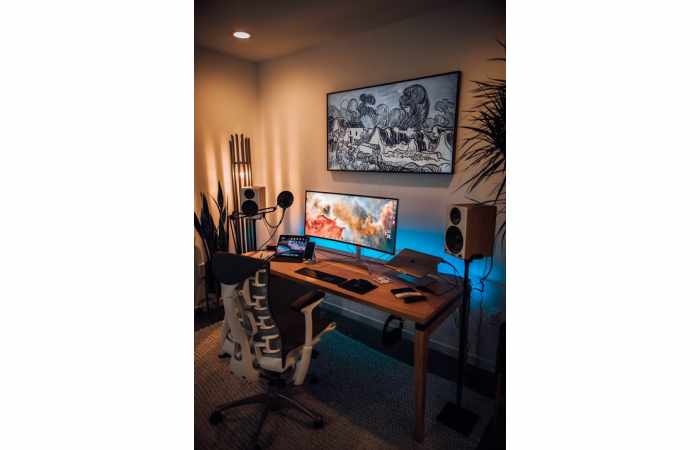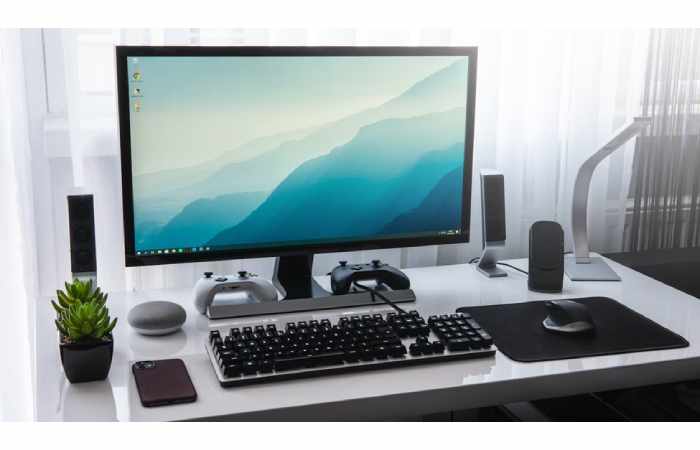Remote work changed everything about how we work. But most people set up their home offices in a hurry and never thought twice about ergonomics. They’re using dining chairs, laptops perched on kitchen tables, and wondering why their back hurts after eight hours.
Your workspace setup directly impacts your health, productivity, and how you feel at the end of the day. Poor ergonomics leads to neck pain, back problems, wrist issues, and chronic fatigue. None of that is necessary.
Building an ergonomic workspace doesn’t require thousands of dollars or a complete office overhaul. It requires understanding a few key principles and making smart adjustments. Let’s fix your setup.
The Foundation: Your Chair
Your chair is the single most important piece of equipment in your workspace. You’re sitting in it for hours every day. A bad chair will wreck your posture and cause pain no matter what else you get right.
Quality matters here more than anywhere else. Cheap chairs lack proper lumbar support, have cushions that compress quickly, and use adjustment mechanisms that break. You don’t need the most expensive chair on the market, but you do need something decent.
Key features to look for include adjustable seat height, lumbar support that actually hits your lower back, armrests that move up and down, and a seat depth that fits your legs. The backrest should recline slightly and provide support without forcing you into an uncomfortable position.
There’s an ongoing debate about gaming chairs versus traditional office chairs. Gaming chairs look cool with their racing-inspired designs and bold colors. Office chairs look boring but are often designed by ergonomics experts.
Here’s the truth. Good gaming chairs can be excellent for long sitting sessions because they’re built for people who sit for extended periods. The best gaming chair options include proper lumbar support, multiple adjustment points, and quality materials that hold up over time. Many people find them more comfortable than traditional office chairs.
The key is avoiding cheap knockoffs in either category. Whether you choose a gaming chair or office chair, make sure it has real adjustable lumbar support and quality construction.
Adjustment mechanisms should be easy to use while sitting. If you have to stand up or struggle to make adjustments, you won’t do it. And adjustment is crucial because your body needs different support throughout the day.
Set your chair height so your feet rest flat on the floor with your knees at about 90 degrees. Your thighs should be roughly parallel to the ground. If the chair is too high and your feet dangle, you’re putting pressure on the backs of your thighs. Too low and you’re compressing your hip joints.
Armrests should let your shoulders relax. If they’re too high, your shoulders hunch up. Too low and you’re reaching down, which strains your shoulders and neck. Adjust them so your elbows rest comfortably at your sides.
Desk Height and Monitor Positioning
Once your chair is right, everything else builds from there. Your desk height needs to work with your chair height, not against it.
The 90-degree rule is your friend. When sitting with proper posture, your elbows should be at roughly 90 degrees when your hands rest on the keyboard. Your knees should also be at about 90 degrees. Your ankles too. These right angles put your joints in neutral positions that minimize strain.
Most standard desks are around 29 to 30 inches high. That works for people of average height with their chair adjusted properly. But if you’re taller or shorter, standard desk height might not work for you.
Standing desks have become popular, and they’re worth considering. But standing all day isn’t better than sitting all day. The ideal is alternating between sitting and standing throughout the day. If you get a standing desk, make sure it adjusts easily so you’ll actually use both positions.

Monitor positioning is critical and most people get it completely wrong. Your screen should be at arm’s length away, roughly 20 to 28 inches from your eyes. The top of the monitor should be at or slightly below eye level. This means when you look straight ahead, you’re looking at the top third of the screen.
Why? Because your natural gaze angles slightly downward. Looking up strains your neck. Looking too far down compresses your cervical spine. That slight downward gaze is natural and comfortable for extended periods.
Laptop users face special challenges because the screen and keyboard are attached. Using a laptop as your primary workstation almost guarantees bad ergonomics. Either the screen is too low or the keyboard is too high. You can’t win.
The solution is a laptop stand that raises the screen to proper height, plus an external keyboard and mouse. Yes, this costs extra. But it’s worth it if you’re working on a laptop more than a few hours daily.
Keyboard and Mouse Setup
Your wrists should be in a neutral position when typing. Not bent up, not bent down, not twisted to the side. Neutral means straight, as if you’re shaking someone’s hand.
Keyboard tilt matters. Most keyboards have little feet that lift the back edge up. Don’t use them. This positive tilt forces your wrists to bend upward, which compresses the carpal tunnel. Either keep the keyboard flat or use a negative tilt if possible.
Distance is important too. Your keyboard should be close enough that you’re not reaching. Your elbows should stay near your sides, not stretched forward. Reaching strains your shoulders and upper back over time.
Mouse placement should keep your hand in line with your forearm. Don’t twist your wrist to use the mouse. It should be at the same height as your keyboard and close enough that you’re not reaching.
Some people benefit from split keyboards that angle outward, letting your arms stay in a more natural position. Others find vertical mice reduce wrist strain by keeping your hand in a handshake position. These aren’t necessary for everyone, but they help if you’re experiencing discomfort.
Lighting and Screen Settings
Lighting gets overlooked but dramatically affects eye strain and headaches. Natural light is ideal, but position matters. Your monitor should be perpendicular to windows, not facing them or with your back to them. Both create glare issues.
Task lighting supplements overhead lights. A desk lamp that illuminates your workspace without creating screen glare helps reduce eye strain. Position it to the side rather than directly behind your monitor.
Blue light from screens disrupts sleep patterns and contributes to eye fatigue. Most operating systems now include night mode settings that reduce blue light in the evening. Use them. Screen brightness should roughly match your surrounding light. Too bright in a dark room causes strain. Too dim in a bright room makes you squint.
Glare is your enemy. If you see reflections on your screen, adjust either the screen angle, your lighting, or both. Anti-glare screen protectors help if you can’t eliminate glare through positioning.
The Forgotten Elements

Footrests seem silly until you need one. If your chair is at the right height for your desk but your feet don’t reach the floor, a footrest solves the problem. Dangling feet create pressure points on your thighs and restrict circulation.
Cable management isn’t just aesthetic. Tangled cables are tripping hazards and make cleaning difficult. Use cable clips, sleeves, or under-desk trays to keep everything organized and out of the way.
Room temperature affects comfort and productivity. Too cold and you’re tense, hunching your shoulders. Too warm and you’re sluggish. Most people work best between 68 and 72 degrees Fahrenheit. Air quality matters too. Stuffy rooms cause fatigue and headaches.
Noise control is crucial if you’re in a shared space or noisy environment. Noise-canceling headphones or white noise machines help you focus. Even in quiet spaces, some background sound often improves concentration compared to complete silence.
Movement and Break Strategies
The best ergonomic setup in the world won’t save you if you sit motionless for hours. Movement is essential.
The 20-20-20 rule fights eye strain. Every 20 minutes, look at something 20 feet away for 20 seconds. This relaxes your eye muscles and reduces fatigue. Set a timer if you forget.
Microbreaks throughout the day keep your body from stiffening. Stand up, walk around, stretch for a minute every 30 minutes. These tiny breaks don’t hurt productivity. They improve it by keeping you alert and comfortable.
Simple stretches at your desk help. Shoulder rolls, neck stretches, wrist circles. You don’t need a yoga routine. Just gentle movements that counteract sitting positions.
Walking meetings and standing phone calls break up sitting time. Not every call needs you glued to your chair. Move when you can.
Testing and Adjusting Your Setup
How do you know if your ergonomics are wrong? Your body tells you. Neck pain, shoulder tension, lower back ache, wrist discomfort, eye strain, headaches. These are all signs your setup needs adjustment.
Fine-tuning takes time. Make one change, give it a few days, assess how you feel. Don’t change everything at once or you won’t know what helped.
Professional ergonomic assessments are worth considering if you’re experiencing chronic pain. Occupational therapists and ergonomics specialists can spot issues you might miss. Some employers even cover these assessments.
Budget-friendly improvements exist. You don’t need to spend thousands. A cushion for lumbar support, a stack of books to raise your monitor, a small footrest from a discount store. Small fixes often make big differences.
Conclusion
Building an ergonomic workspace isn’t complicated or expensive. It’s about understanding how your body works and setting up your environment accordingly.
Small changes create big impacts on your daily comfort and long-term health. Start with your chair and monitor position. Those two changes alone will help most people significantly.
You’re investing in your health and productivity. Your future self will thank you. Start adjusting your workspace today.

